
Flotation is one of the important methods for gold beneficiation and gold extraction. It is generally suitable for processing gold-bearing sulfide minerals, or gold minerals associated with other metals such as copper, lead, and zinc. The following will analyze gold froth flotation from four aspects, namely gold ore flotation process, gold ore flotation process, gold ore flotation reagent and gold ore flotation equipment.
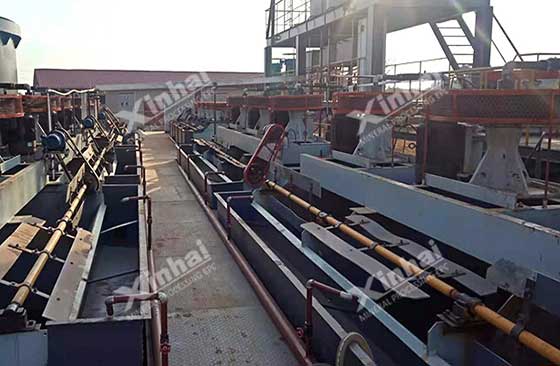
The flotation process is to generate hydrophobicity (oleophilic gas) on the mineral surface, and aggregation occurs at the liquid, gas or water-oil surface. After a series of operations, the gold particles have affinity with air bubbles and chemicals, float on the surface of the equipment, and then be recovered as foam products. Generally speaking, the flotation process of gold ore is mainly divided into crushing and grinding stage, pulp preparation stage and flotation stage.
Crushing and grinding stage: Before the gold ore is flotated, the raw ore needs to be ground to a certain particle size, so that the gold ore particles and other gangue minerals can reach a single dissociation state. At the same time, it is necessary to control the mineral particle size to make it meet the flotation requirements. Mainly, the raw ore is crushed and screened for work, and the minerals are initially dissociated, and then they are finely ground in a ball mill to complete the monomer dissociation between minerals.
Slurry preparation stage: This process is mainly to adjust the slurry concentration, add flotation reagents, adjust the pH of the slurry, and eliminate harmful ions in the flotation process before the minerals enter the flotation machine, so as to change the properties of the mineral surface and meet the flotation requirements.
Flotation stage: This stage can be divided into two parts. The first part is flotation, appropriate air needs to be introduced into the flotation machine to form a large number of air bubbles, so that the ore particles adhere to the air bubbles and float to the pulp together with the air bubbles. surface to form a foam layer. The second part is to scrape out the floating foam product for the purpose of flotation.
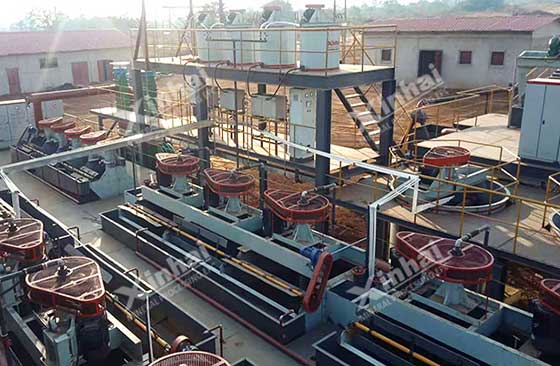
For vein gold ore, the gravity separation method is generally used for recovery. The gold ore containing sulfide ores or other associated minerals needs to be enriched by flotation. However, the finished gold cannot be finally obtained, and it needs to be combined with other methods to form a combined process for selection. Commonly used flotation gold ore processes are: flotation + flotation concentrate cyanation, flotation+concentrate roasting+calcination cyanidation, flotation+flotation concentrate pyrolysis, flotation+tailings/middle ore Cyanidation and concentrate roasting, cyanidation process of raw cyanide ore, etc.
Flotation+flotation concentrate cyanidation: This method is mainly suitable for the treatment of gold-bearing quartz vein type sulfide ore. First, a small amount of concentrate is obtained by flotation, and then cyanidation is carried out to extract gold.
Flotation+concentrate roasting+calcine cyanation: This method is generally suitable for the treatment of insoluble gold minerals, such as arsenic-containing gold minerals, gold minerals containing zinc and sulfide, etc. The concentrate is obtained by flotation first and then roasted. The main purpose of roasting is to remove arsenic and antimony elements in the cyanation process.
Flotation+flotation concentrate pyroprocessing: This method is suitable for processing polymetallic sulfide gold ore. During flotation, gold will enter the copper or lead concentrate that is closely symbiotic with it, and the obtained copper-gold concentrate or lead-gold concentrate is directly sent to the smelter for smelting, and the gold concentrate is recovered from it.
Flotation+tailings/middle ore cyanidation+concentrate roasting cyanidation: This method is suitable for processing gold-bearing minerals such as gold, pyrrhotite, chalcopyrite and other sulfide minerals. The easily floating gold sulfide of this type of ore can be produced as concentrate, and then the medium ore and tailings are roasted and then hydrogenated to obtain the gold and silver minerals remaining in the medium and tailings.
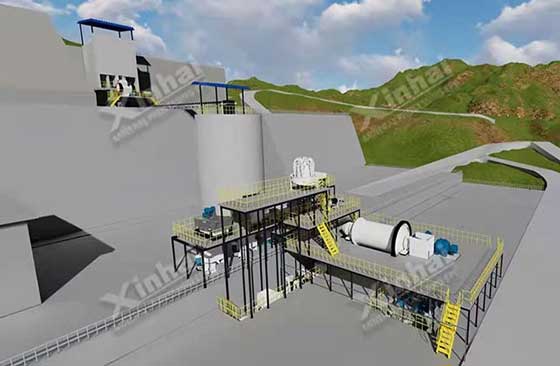
To ensure the smooth progress of the flotation process, during the flotation process of gold ore, it is necessary to add chemicals to change the floatability of the mineral surface, enhance the dispersion of air in the pulp, increase the stability of the foam, and eliminate the ions that harm the flotation process. Wait. According to the different properties of action, flotation agents can generally be divided into three categories: collectors, foaming agents and regulators.
Collector: Its main role is to amplify the differences in wettability between minerals. A hydrophobic film is formed on the surface of the minerals, which is conducive to the attachment of ore particles and air bubbles, so as to play a role of collection, so that the gold-bearing minerals can be effectively separated from the gangue minerals. According to the different polar groups of the agent and the surface of the mineral, the commonly used collectors in gold beneficiation are: xanthate, black medicine, ammonium black medicine.
Foaming agent: Its main function is to reduce the surface tension of the interface between water and air, so that the bubbles form a large and stable foam, which is used as a medium for sorting floatable minerals and other minerals. Commonly used foaming agents for gold beneficiation are: No. 2 oil, camphor oil, heavy pyridine, cresol acid, etc.
Regulator: Its main function is to change the surface properties of minerals, improve the selectivity of the flotation process, enhance the efficiency of the collector, and improve the flotation conditions of the pulp. According to their different action properties, adjusters are also divided into active agents, inhibitors and pH adjusters. Commonly used inhibitors in gold concentrators are lime, cyanide, sodium sulfide, dichromate, etc.; adjusters include lime, sodium carbonate, caustic soda and sulfuric acid.
Activator: Its main function is to create a film on the surface of the mineral that promotes the attachment of the collector, and to improve the floating ability of the mineral, so as to remove the inhibitory film on the mineral surface and restore the original floating activity of the mineral. Commonly used activators in gold ore dressing plants are: sodium sulfide, lead nitrate, lead acetate, copper sulfate, etc.
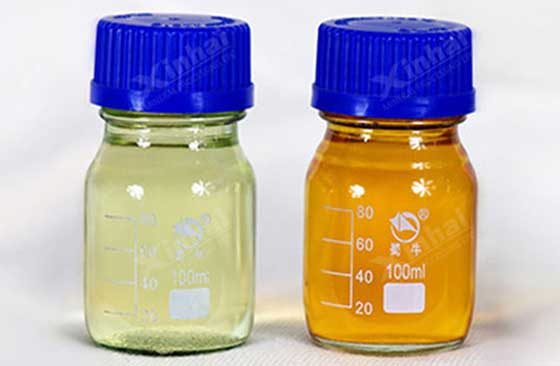
The flotation machine is the necessary equipment to complete the whole flotation process. The commonly used flotation equipment in gold ore dressing plants are mainly mechanical agitated flotation machines and aerated agitated flotation machines, followed by rod flotation machines and flotation columns.
Mechanical stirring flotation machine: it has the function of self-aspirating. During operation, the machine relies on the stator rotor to complete the aeration and agitation of the pulp. Since there is no need for an external charging and inflating device, the middle mine can return by its own flow, and can be set horizontally, eliminating the input of a lift pump. The main equipments are: SF type, JJF type and BF type flotation machine. Among them, SF type flotation machine is suitable for medium and large gold ore dressing plants for roughing and sweeping. JJF flotation machine is suitable for all kinds of plants for sweeping and selecting. BF type flotation machine is suitable for medium and small gold ore dressing plants for roughing.
Air-filled stirring flotation machine: It does not have the function of self-aspirating, so it needs to be equipped with an external aeration device. The pulp is stirred by agitators and air is fed by an external blower. However, when the mine returns, it needs to be transported by a lift pump. The main equipments are: XCF type and KYF type flotation machine. Among them, the XCF flotation machine is suitable for roughing and sweeping operations in medium and large gold ore dressing plants. KYF type flotation machine is used for processing relatively single gold ore, doing roughing and sweeping operations.
Rod flotation machine: Similar to stirring flotation machine, it is also a self-aspirating flotation device. It uses the rotation of the rod wheel to form a negative pressure inside, and sucks through the hollow shaft to realize the mixing of slurry and gas to complete the flotation operation. It is generally suitable for medium and small gold ore dressing plants for roughing operations.
Flotation column: It is a deep trough compressed air flotation equipment, which is supplied with air by an inflatable device during operation. Gold-bearing sulfide ores are mostly processed in small-scale concentrators in gold ore concentrators.
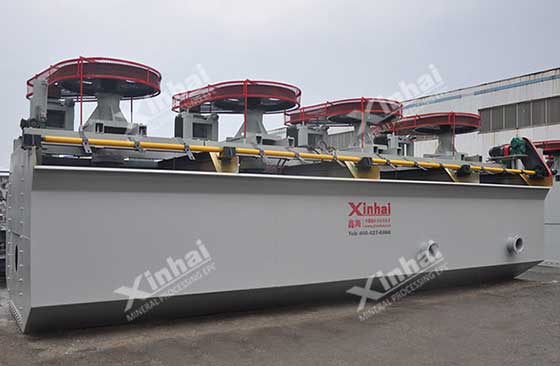
The above is the introduction of gold ore flotation process, flotation process, flotation reagents and commonly used flotation equipment. Flotation, as an important process for gold beneficiation, must not be blindly selected whether it is the process flow or flotation equipment. The concentrator should determine the appropriate process according to the properties of the gold ore and the selection requirements. Therefore, Xinhai proposes to design a reasonable gold ore beneficiation process, suitable type and dosage of reagents and reasonable gold ore flotation equipment through mineral beneficiation test analysis.
To find out more about our products and solutions, please fill out the form below and one of our experts will get back to you shortly.